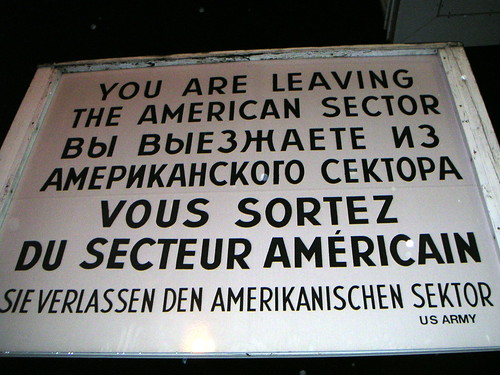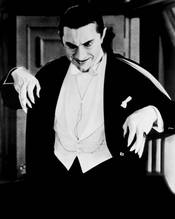Question 1: Where is this sign?

This is a replica of the original Checkpoint Charlie sign that’s been erected right next to a replica of the original Checkpoint Charlie hut (you can see a bit of the hut’s roof in the corner of the picture), at, guess where, Checkpoint Charlie, Berlin. The original sign is in the Checkpoint Charlie museum; you can see pictures here and here.
Question 2: The phrase “Velvet Revolution” is used to describe what political event?
That would be the relatively painless overthrown of the communist regime in Czechoslovakia and the subsequent renaming of the country into “The Czech and Slovak Federal Republic.” That was shortly followed by the Velvet Divorce, wherein the Czechs and the Slovaks went their separate ways.
 Question 3: The name of what region of Romania translates as “across the forest”?
Question 3: The name of what region of Romania translates as “across the forest”?
Transylvania, home of… well, you know.
Question 4: Despite winning the Nobel Prize for Literature, which author’s only published work in his homeland for nearly 30 years was One Day in the Life of Ivan Denisovich?
Aleksandr Solzhenitsyn, most famous for writing The Gulag Archipelago. He has turned into a bit of a fruitcake in post-Soviet Russia, unfortunately…
Question 5: When students of the Cold War talk about Fishbed, Flanker, Fulcrum, and Flogger, what are they referring to?
Soviet-era fighter planes, specifically the MiG-21, the Su-27, the MiG-29, and the MiG-23. “Essqueue O’Peetie” pretty much nailed that one, though he left out the bit about words beginning with “F” being fighter planes, “B” designating bombers, and so on.
Question 6: Name what’s missing from the following list: Serbia, Macedonia, Kosovo, Macedonia, Montenegro, Croatia, Bosnia & Herzegovina.
What’s missing is Slovenia, the sole province of the former Yugoslavia to exit Yugoslavia with relatively little strum und drang, and thus, the one that everyone forgets about.
Question 7: What hit pop song was about the accidental start of World War III and the subsequent destruction of the world?
“99 Luftballons” (or, in English, “99 Red Balloons”) by Nena. You know, for a song about the end of the world, it’s surprisingly peppy.
Question 8: What was, quite literally, Josip Broz’s life work?
Josip Broz was better known as Tito, who was given the title President for Life in 1974, after having been elected President of Yugoslavia six times between 1945 and 1971. Thus, his life’s work was being President of Yugoslavia. Interestingly enough, Tito was one of the relatively few Presidents for Life who actually managed to serve out their term in office.
Question 9: What do the Russian cities of Nizhy Novgorod, St. Petersburg, Volgograd, and Yekaterinburg have in common (other than the obvious, i.e. that they’re all Russian cities)?
They were all renamed by the Soviets after Soviet heroes and then subsequently re-renamed. See the chart below:
Nizhy Novgorod —> Gorky (1932) —> Nizhy Novgorod (1991)
St. Petersburg —> Petrograd (1914) —> Leningrad (1924) —> St. Petersburg (1991)
Tsaritsyn —> Stalingrad (1925) —> Volgograd (1961)
Yekaterinburg —> Sverdlovsk (1924) —> Yekaterinburg (1991)
Question 10: General Wojciech Jaruzelski did what on December 13, 1981?
That was the day that the General, who was Polish Prime Minster at the time, declared martial law. His explanation was that he did it to avoid a Soviet invasion (ala Hungary 1956 and Czechoslovakia 1968). While this is at least a semi-plausible excuse, it doesn’t really hold up under closer viewing.
Next week: World Literature!
I have to say that I am amused by the ads that Google has generated for this entry...